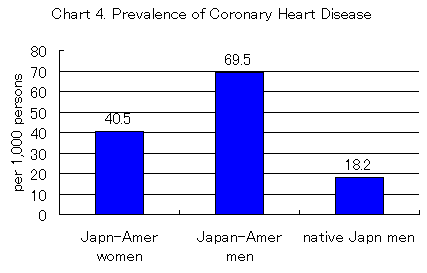Coronary Heart Disease Study
The age-adjusted prevalence rate of coronary heart disease (determined by irreversible myocardial cell death diagnosed by electrocardiogram or history of coronary heart disease) was significantly higher in both Japanese American men (69.5 per 1000 persons) and Japanese American women (40.4 per 1000 persons) than among native Japanese men (18.2 per 1000 persons) .The difference between Japanese American men and women would be explained by the well-described protective effect of estrogen in women and unfavorable risk factors affecting Japanese American men such as their higher TC/HDL-C ratio, higher rates of hypertension and diabetes, and higher rates of current and previous smoking.

The difference of the prevalence of coronary heart disease between Japanese American men and native Japanese men would be explained by unfavorable risk factors affecting Japanese American men including a higher TC/HDL-C ratio (4.7 in Japanese American men vs. 3.7 in native Japanese men), a higher rate of hypertension (19.7% vs. 10.8%), a higher rate of diabetes (6.4% vs. 3.4%), and lower average daily alcohol consumption (7.0 grams/day vs. 27.3 grams/day). Native Japanese men may also have exhibited the “healthy worker” effect. Another possible factor affecting such a difference in coronary heart disease prevalence would be diet, which we are studying now.
Publications and Presentations
Namekata T, Suzuki K, Moore D, Hughes D, Mori M, Hatano S, Hayashi C, Knopp R, Marcovina S. Coronary heart disease and its risk factors among Japanese Americans in Seattle and native Japanese in Japan (abstract). American Journal of Epidemiology 1997; 145(11): supplement p.84.
Namekata T. Genetics vs. Environment in Heart Disease and Stomach Cancer. Washington Public Health 1999; 16:8-11.